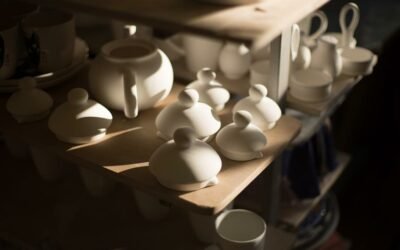Are your succulents suffering from mold? Don't worry, you can tackle this problem head-on.
In this article, we will guide you through the steps to get rid of mold on your succulents. We'll help you identify the signs, remove affected parts, adjust watering and humidity levels, and apply a natural mold treatment.
With our expert advice, you'll be able to prevent future mold growth and ensure the health of your succulents.
Let's get started!
Key Takeaways
- Fuzzy or powdery growths on leaves and stems are signs of mold on succulents.
- Mold on succulents is commonly caused by high humidity and overwatering.
- Prompt action is necessary to prevent further spread of the mold.
- Removing affected leaves and stems, adjusting watering and humidity levels, applying a natural mold treatment, and practicing proper care and maintenance are effective ways to get rid of mold on succulents.
Identify the Signs of Mold on Succulents
To identify the signs of mold on your succulents, carefully examine the leaves and stems for fuzzy or powdery growths. Mold can be a common problem for succulent plants, especially when they're exposed to high humidity or overwatering.
One of the most common types of mold that affects succulents is powdery mildew, which appears as a white or grayish powder on the leaves and stems. This fungus can spread quickly and should be addressed as soon as possible.
Another type of mold that can affect succulents is fuzzy mold, which appears as a soft, fuzzy growth on the leaves and stems. This type of mold is usually caused by excessive moisture and poor air circulation. It can be identified by its fuzzy texture and can range in color from white to gray or even black.
In addition to fuzzy and powdery growths, mold on succulents can also cause other symptoms such as leaf discoloration, wilting, and stunted growth. If you notice any of these signs, it's important to take action to prevent further spread of the mold.
Remove Affected Leaves and Stems
To remove affected leaves and stems, carefully trim them off using clean pruning shears. Mold-infected succulents require prompt action to prevent further spread and ensure the health of the plant.
Begin by inspecting the affected plant parts. Look for any discoloration, soft spots, or fuzzy growth, as these are signs of mold infestation. Once identified, grab a pair of clean pruning shears and sterilize them by wiping the blades with rubbing alcohol or hydrogen peroxide. This step is crucial to prevent the transfer of mold spores to healthy parts of the plant.
Next, position the shears close to the base of the affected leaf or stem, making a clean and precise cut. Be cautious not to damage the surrounding healthy tissues. After each cut, wipe the shears with alcohol or hydrogen peroxide before moving on to the next affected area.
Dispose of the infected plant parts in a sealed bag, as mold spores can easily spread through the air. Remember to wash your hands thoroughly after handling the mold-infected material to avoid contamination.
Removing affected leaves and stems is an essential step in the process of eliminating mold from your succulents and restoring their overall health.
Adjust Watering and Humidity Levels
Are you wondering how to adjust watering and humidity levels to get rid of mold on your succulents? Here are some expert tips to help you prevent and eliminate mold growth on your beloved plants:
- Water sparingly: Succulents are adapted to survive in arid conditions, so they don't require frequent watering. Overwatering can create a damp environment that promotes mold growth. Only water your succulents when the soil is completely dry, and make sure to allow excess water to drain out of the pot.
- Use well-draining soil: Succulents thrive in soil that allows water to flow freely, preventing excess moisture from accumulating around the roots. Choose a well-draining soil mix specifically formulated for succulents or add perlite or sand to improve drainage.
- Increase air circulation: Good air circulation helps to reduce humidity levels and discourage mold growth. Place your succulents in areas with adequate airflow, such as near an open window or a fan. Avoid crowding your plants too closely together, as this can restrict air movement.
- Monitor humidity levels: Mold thrives in high humidity environments. Invest in a hygrometer to measure the humidity levels in your succulent's environment. Ideally, the humidity should be below 50%. If it's too high, consider using a dehumidifier or placing a bowl of silica gel near your plants to absorb excess moisture.
Apply a Natural Mold Treatment
For effective mold treatment on your succulents, consider using a natural solution made with ingredients you may already have at home. Natural mold treatments can effectively eliminate mold growth on your succulents without the use of harmful chemicals.
One effective natural treatment is a mixture of water and apple cider vinegar. To create this natural mold treatment, mix one part apple cider vinegar with three parts water in a spray bottle. Shake the bottle well to ensure the ingredients are thoroughly combined. Next, spray the mixture directly onto the affected areas of your succulents, ensuring complete coverage. The acetic acid in the apple cider vinegar helps to kill the mold and prevent its regrowth.
Another natural mold treatment option is a mixture of baking soda and water. Mix one teaspoon of baking soda with one cup of water until it forms a paste. Apply the paste directly onto the moldy areas of your succulents and let it sit for about 15 minutes before rinsing off with water. Baking soda is known for its antimicrobial properties, which can help to eliminate mold and prevent its recurrence.
These natural mold treatments provide an effective and safe way to rid your succulents of mold without the use of harsh chemicals.
Prevent Future Mold Growth With Proper Care and Maintenance
To prevent future mold growth on your succulents, you need to ensure that you provide proper care and maintenance. Here are four key steps to follow:
- Proper watering: Overwatering is one of the main causes of mold growth on succulents. To avoid this, water your succulents only when the soil is completely dry, and make sure to water them at the base, avoiding the leaves. Additionally, consider using well-draining soil to prevent water from sitting around the roots.
- Adequate sunlight: Succulents thrive in bright, indirect sunlight. Ensure that your plants are getting enough light by placing them near a window or in an area with sufficient natural light. However, be cautious of placing them in direct sunlight for extended periods, as this can lead to sunburn.
- Proper air circulation: Good air circulation is essential for preventing mold growth. Avoid overcrowding your succulents and make sure they've enough space between them. This will allow air to flow freely, reducing the chances of mold development.
- Regular cleaning: Dust and debris can accumulate on the leaves of succulents, creating a favorable environment for mold. Regularly wipe the leaves with a soft cloth or brush to remove any buildup. This won't only prevent mold growth but also help your succulents maintain their vibrant appearance.
Conclusion
In conclusion, it's crucial to promptly identify and address signs of mold on succulents to ensure their health and longevity. By removing affected leaves and stems, adjusting watering and humidity levels, and applying a natural mold treatment, you can effectively eliminate mold growth.
Additionally, practicing proper care and maintenance, such as providing adequate air circulation and avoiding overwatering, will help prevent future mold issues. Following these expert tips will ensure the thriving of your succulents and maintain their aesthetic appeal.






0 Comments